June, 1958
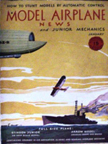

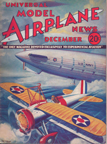

Curtiss "Sparrowhawk" (and the Dirigible USS Akron)
Model Airplane News Cover Art for August, 1932, December 1933, and June, 1958
by Jo Kotula
Click to Enlarge
The Navy planned to use dirigibles as advance scouts for the fleet. The dirigible was nearly silent and could cover vast areas of ocean. It was desired to extend the range of search even further by equipping the dirigible with its own fleet of airplanes, turning it into a flying aircraft carrier. The January, 1931 cover shows a hypothetical situation where the back of the airship is depicted as a hangar. By the 1932 issue the problem had been solved: the Curtiss F9C Sparrowhawk was a light 1930s biplane fighter aircraft that was carried by the United States Navy airships USS Akron and Macon.
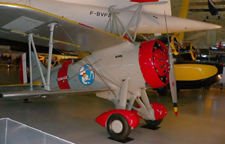
Restored Curtiss "Sparrowhawk" in the Air and Space Museum
Click to Enlarge
The Sparrowhawk is an example of a parasite fighter, a small airplane designed to be deployed from a larger aircraft such as an airship or bomber. At 20 ft long and with only a 25 ft wingspan, the Sparrowhawk was ideal for service in the fighter complement of large rigid-framed airships because of its small size. Although the Sparrowhawk was armed, its primary duty was reconnaissance, and it provided the airships it served with a much wider search area. Akron was reported to have a complement of three Sparrowhawks, while Macon was discovered at its underwater resting place with four in its hangar.
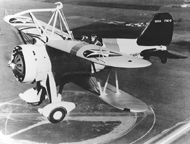
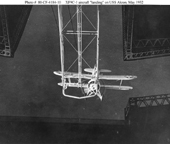
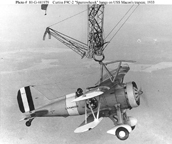
Curtiss "Sparrowhawk" using the "Flying Trapeze"
Left: Details of the "hook"
Middle: Approaching the Trapeze, seen from inside the Dirigible
Right: Hook is clamped on the trapeze, ready to lower the tail "yoke"
Click to Enlarge
To achieve launching and recovery from the airship, a hook/anchor system was developed, dubbed by crews as "the flying trapeze". The Sparrowhawk had a hook mounting on its top wing that attached to the cross-bar of the trapeze. For launching, the biplane's hook was engaged on the trapeze inside the (internal) hangar, the trapeze was lowered clear of the hull into the (moving) airship's slipstream and, engine running, the Sparrowhawk would then disengage its hook and fall away from the airship. For recovery, the biplane would fly up underneath its mother ship, moving slightly faster than the airship, and in a somewhat tricky maneuver hook onto the trapeze; the width of the trapeze cross-bar allowed a certain lateral lee-way in approach, the biplane's hook mounting had a guide rail to provide some tolerance against relative vertical motion (see photo), and engagement of the hook was automatic on positive contact between hook and trapeze. More than one attempt might have to be made before a successful engagement was achieved, for example in gusty conditions. Once the Sparrowhawk was securely caught, its engine could be safely cut and it could then be hoisted by the trapeze back within the airship's hull.
One interesting use of the Sparrowhawks was to act as "flying ballast". The airship could take off with additional ballast or fuel aboard instead of its airplanes. Once the airship was cruising, the aircraft would be flown aboard, the additional weight being supported by dynamic lift until the airship lightened.
Here is a video of the Curtiss "Sparrowhawk" (and the Dirigible USS Akron) in action:
Click Here for more information about the Curtiss F9-C "Sparrowhawk".
The idea of adding fighter protection to a lumbering giant did not die with the dirigible. The politically charged B-36 -- a propellor plane in the days of Mach One fighters -- was "propped up" by incorporating the parasite fighter, in this case, the F-85 "Goblin"
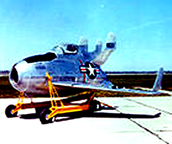
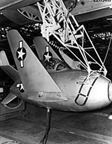

Click to Enlarge
The approach was almost the same as with the dirigibles -- one bomber would carry three fighters inside its bomb bay and launch them to protect the rest of the formation. Later, as shown in the clipping from the November 1953 issue of Popular Mechanics, the Goblin was replaced by a F-84 which was released to actually deliver the nuclear weapon while the ultra-slow B-36 stood off. It is possible (although classified) that this arrangement may have been used to conduct reconnaissance missions prior to the development of the U-2.

Click to go back and select another cover.
Counter for the Entire Site (not just this page..)
Home | About Lindy | Last Week's Reviews | Upcoming Events | 1940s Collecibles
The Guide - Establishments - Travel - Accessories
Music | Links | Photo Gallery | Extras | Contact